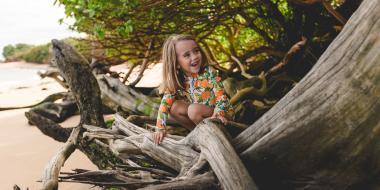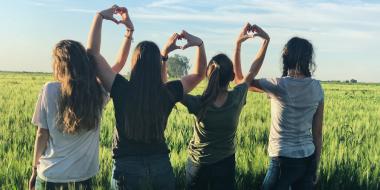“Every mushroom is edible,” a fungi expert once told me. “Really?” I immediately replied. His side-glance revealed he couldn’t believe I fell for it as he responded with, “Once.” It was a nice reminder that sometimes I have to use my common sense when it comes to the outdoors (and wait for punch lines before responding). Regardless, I find mushrooms one of the most intriguing life forms in the forest (as do children) and one that I know the least about. My heart has stopped a few times when I have found my children playing with the pieces of a wild mushroom. I have been known to say in times of panic, “NEVER go near a mushroom again!” Then of course at dinner they look at me questioningly. “Really mom, no mushrooms ever?” Note to self. No sweeping generalizations when panicked, just stay calm, and remember that children will test their parents. That is why I will be the first to admit parenting in the outdoors can be like a mushroom. It can be gloriously therapeutic or just simply toxic.
When I lived in the Yukon, outdoor adventures were stunningly therapeutic. After a hike alone in the woods, I would arrive home renewed and energized . . . until I had three children. Just going into the backyard was more effort than I was willing to expend most days. It took twenty minutes to dress the kids to venture out into the cold while only to have them enter back through the door 10 minutes later. This ensured I rarely took my kids outside in the winter, which turned out to be toxic for my sanity. So I ventured back into the land of many people, fewer spaces, longer days, and warmer weather with the understanding that I just had to work harder to find the ecological freedom I experienced in the Yukon.
Living in the city meant we had to drive for hours to find a semi-wild forest. Considering children’s initial reaction to any outdoor setting is usually one of anarchy, arriving at a remote wilderness area after a long drive is like taking this anarchy and turning it into complete chaos. Then try to communicate the orders. If I am at home on a playground, I caution kids to watch out for a slippery spot or a broken swing. But in a forest setting, those simple communications turn to major life-altering demands like, “Don’t eat this or you will DIE!” or, “Stay away from that because you will DIE!”
On one particular trip my children had been sitting still in a van for five hours on the way to a campground. They all started salivating as I backed into our perfect camping spot and as soon as I stopped, the van door was thrown open and out jumped my youngest before I had a chance to scan the area for potential threats. As he ran into the forest that surrounded us, he started screaming wildly. While trying to ignore his usual antics and set up the tent, I missed hearing the cries of pain that soon followed the screams of joy. Stinging nettles.
As I soothed his wounds, I explained to him that although it stings now, he would thoroughly enjoy the dried stinging nettles that I had added to the spaghetti sauce for dinner. “But they make you strong,” I explained, “and you are what you eat so wouldn’t it be cool to have the power of those stinging nettles?” That did it. My son became the Stinging Superhero of the campsite for the rest of the trip. A potentially toxic situation, turned glorious.
As my children will attest to, outdoor adventures, regardless of their location, will involve taking on some risk. But contrary to popular opinion, taking a calculated risk is decidedly non-toxic. Introducing children to the element of risk while they are young lessens their need to take “larger” risks when they are older. To me, the risk of the odd sting from a stinging nettle is a logical way to hopefully prevent a cracked-out teenager at seventeen.
But what if a wolf eats my grandma? Much to my chagrin are the fairy tales and TV shows that scare children and feed them mistruths about the wild outdoors. While it is important for parents to point out the stinging nettles and wild mushrooms to children, children who spend their lives in front of screens that depict a distorted version of real life are the ones truly at risk.
As a parent, it is important to distinguish between a real risk and a perceived risk before denying a child one of the most exciting experiences of their young lives. A real risk is one that possesses an actual threat to your child. Like eating an unidentified wild mushroom or putting honey on a child’s hand to feed to a bear (this has been done before!). A perceived risk is one that is based on a lack of true understanding and is easily remedied through education and experience.
A child knows how to distinguish between these risks naturally. Watch a child as they learn to climb a tree. First, they watch other children climb the tree. If their friend falls, they determine the tree a real risk and walk away. If not, they will shake the tree trunk a little to see if their friend will fall out. Next, they will jump to the first branch and hang for as long as they can with their hands, feet dangling only a few inches off the ground. Once they feel secure with this they will lift themselves up a little at a time and will go only as far as they instinctually know they can. Then they retreat and try again, moving higher each time until the tree poses no risk to them at all, but merely an adventure. Parents can either push them too fast or scare them out of trying at all.
Considering how long the world has been covered with trees and how long children have been climbing them, I feel the real risk is not letting a child develop this and other natural outdoor abilities. Provide a forest setting, identify the real risks, then sit back, watch, and celebrate. Give them the independence and the challenge they need without the pressure. Let them learn to trust their instincts and hope they don’t fall into a patch of wild mushrooms. If they do, stay calm, get out a book, look on the Internet, or ask an expert to find out if it poses a real or perceived risk. If it is okay, cook it for dinner and the only risk will be having a child in the house that has eaten wild mushrooms and turned into a Wild Child!
*Originally published March 1, 2013






